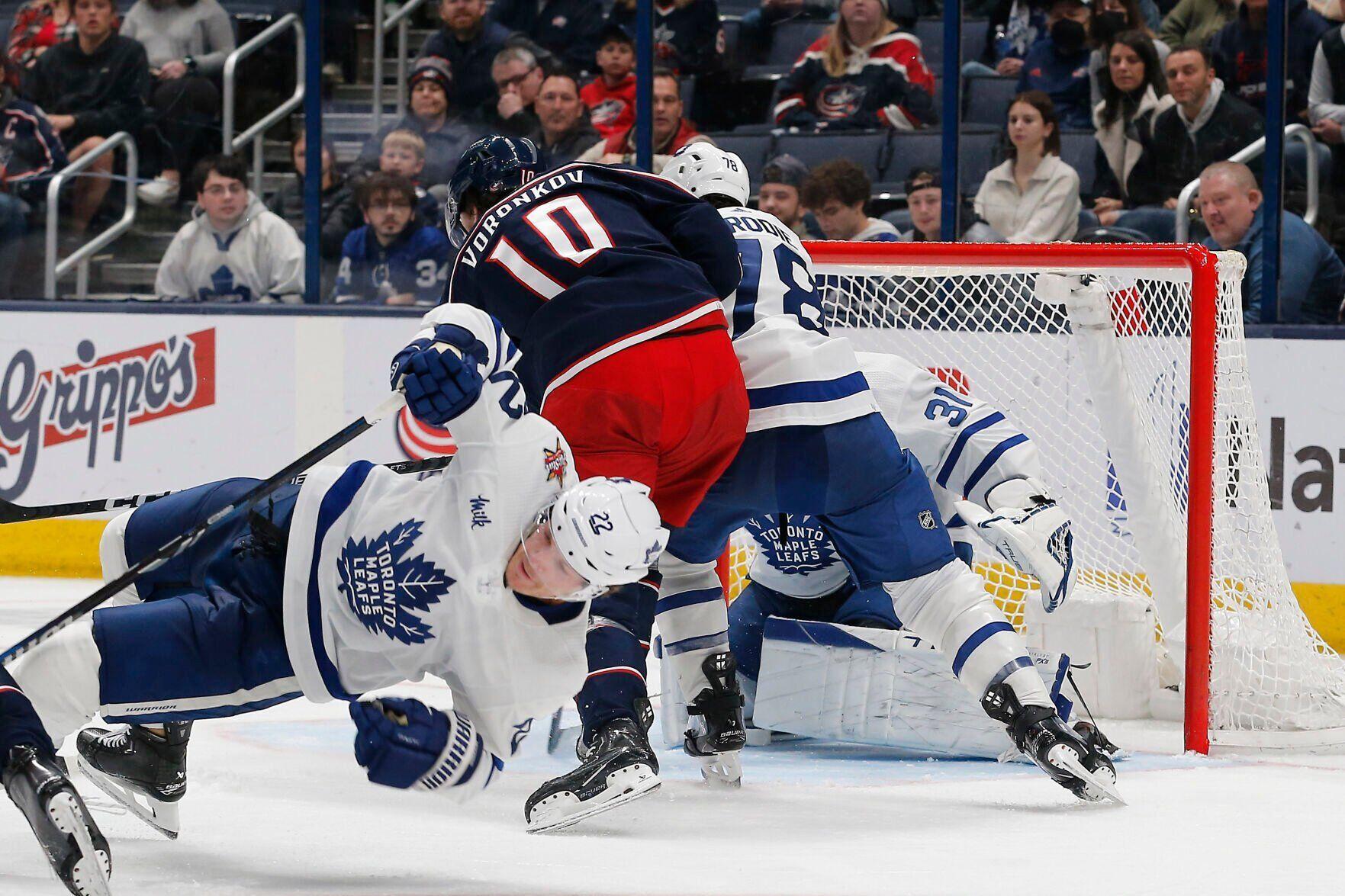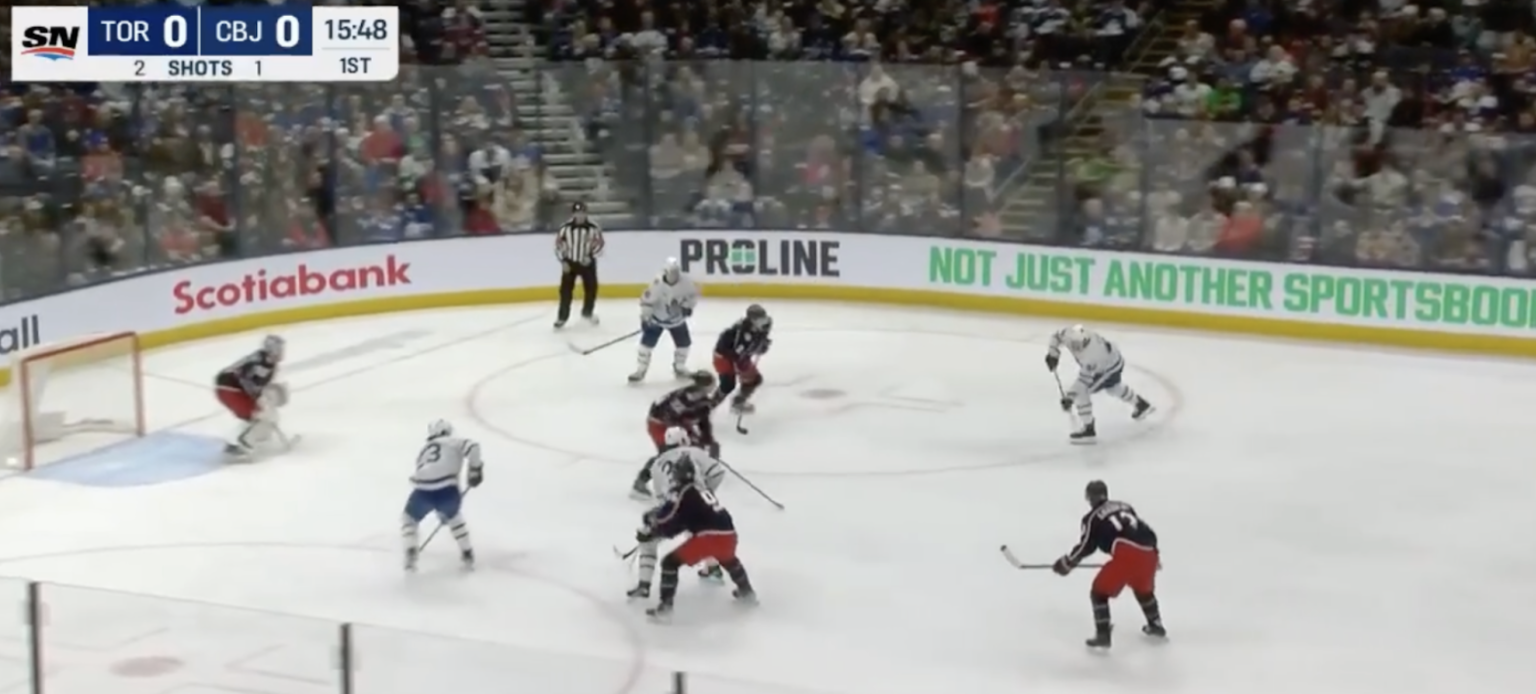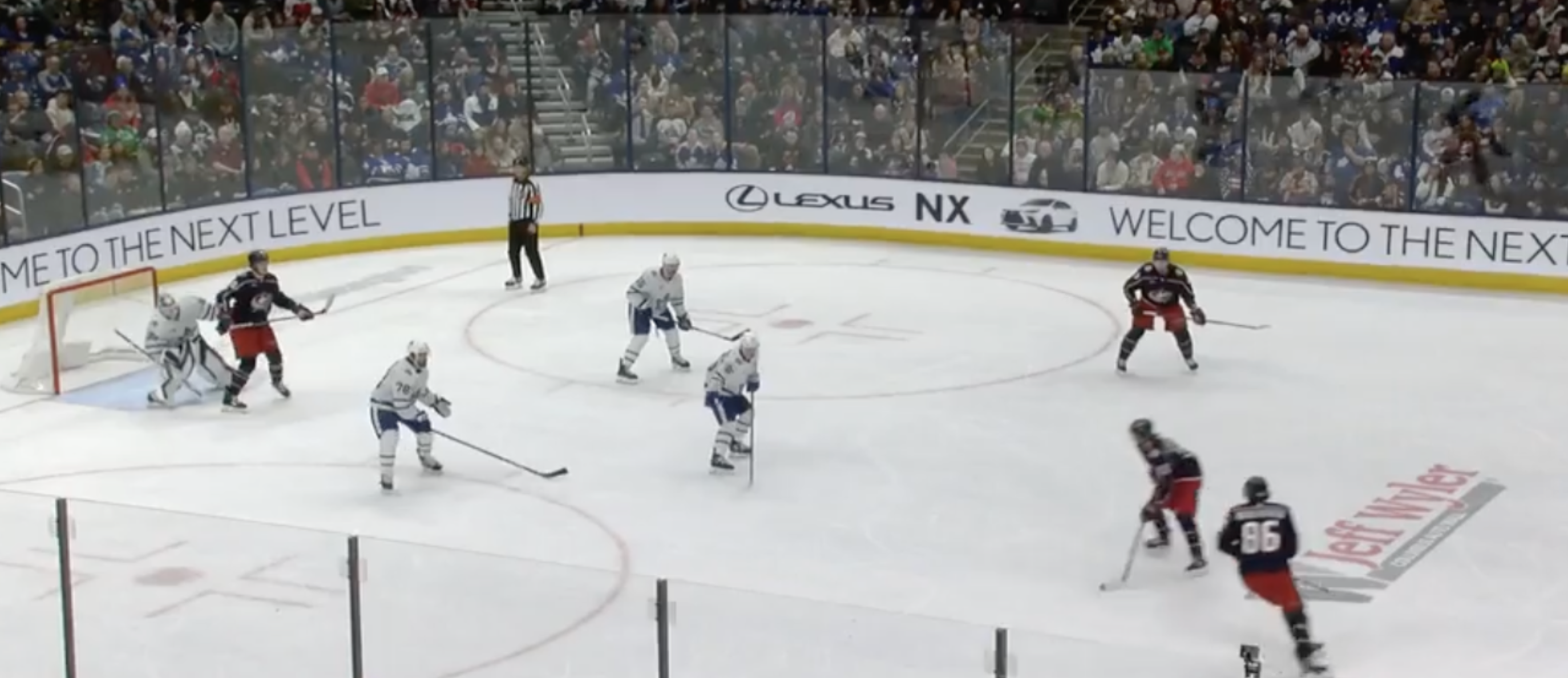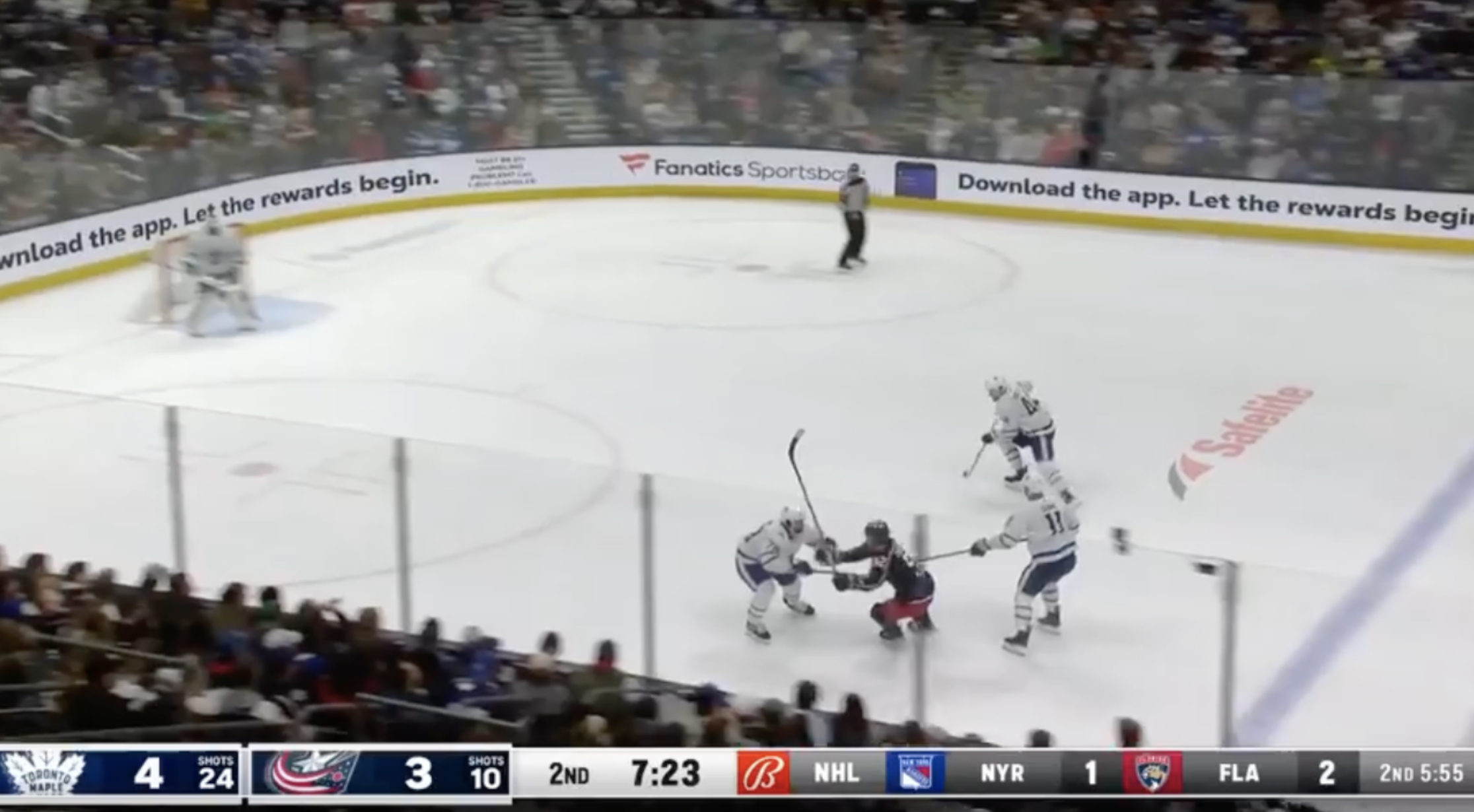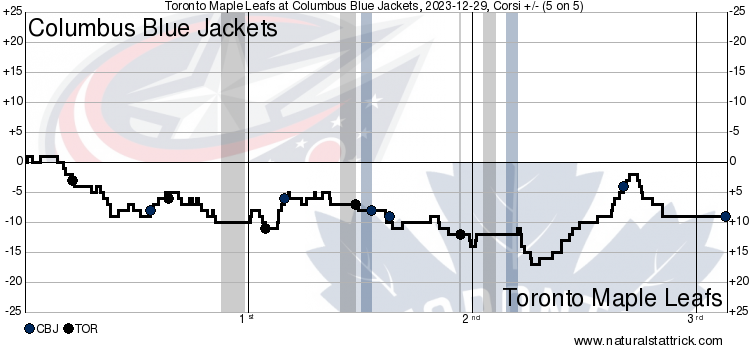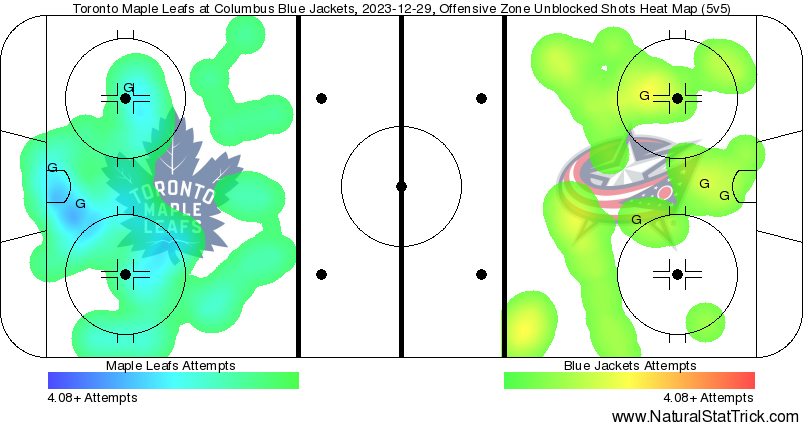Well, the good news is that the Toronto Maple Leafs don’t play the Columbus Blue Jackets again this season.
Two brutal 6-5 losses in overtime, each with their own unique and eventful circumstances, in just the last two weeks.
Let’s get right to it with the game in 10:
1. Coming off of a loss and with a struggling Ilya Samsonov starting in goal, the Leafs got off to the type of start that sets them up for success. They weren’t exploding out of the blocks guns blazing or territorially dominating Columbus, but they were tight-checking, gave the Blue Jackets nothing, and scored just over four minutes into the game.
The play was also a good example of why the Blue Jackets are such a poor team as Johnny Gaudreau picked up the puck in his own zone and decided to go end-to-end against a top-10 team in the league. Not only did it not work, but he tried curling up high with the puck for a high-risk, low-reward play. Matthew Knies checked him tightly to create a turnover, sending the Leafs off to the races.
Morgan Rielly pounced on the loose puck, immediately head-manned it up to Mitch Marner on the far side of the ice, and Rielly did what he is so good at doing: He joined the rush. As the trailing high player, Rielly was wide open for Marner’s drop pass.
Knies went to the net and so did Auston Matthews, forcing multiple Columbus players to naturally gravitate toward #34:
The pass hit a skate and bounced to Marner, who tapped it into the empty net. It was nice to see Knies rewarded with an assist after he forced the initial turnover.
2. Up 1-0, the Leafs kept their foot on the pedal and really pushed for the insurance marker. Auston Matthews took a drop pass from Matthew Knies for a clean look. Max Domi walked in all alone and was robbed by Elvis Merzlikins before setting up Calle Jarnkrok for a missed chance in the slot.
Toronto’s offense was building before a familiar issue once again reared its head. Columbus tied the game on yet another play where the Leafs cleanly held possession in their own zone but gave it away, directly leading to a goal against.
In this case, Timothy Liljegren skated around his own net under some light pressure and blew a tire. From there, the Leafs were caught out of possession and Nick Robertson, in particular, was caught in no man’s land when he should have protected the top of the circle.
With plenty of time and space to look up, Cole Sillinger picked a spot and ripped it. There’s not much blame we can place at the feet of Ilya Samsonov for this one.
3. That was really the only blemish of the period for the Leafs in what was otherwise a strong showing in the opening frame. The overall shots were 15-4 in Toronto’s favour, which was representative of the flow of play.
The Leafs went back to creating chances after the Blue Jackets tied it. Barely a minute and a half after Columbus scored, the Leafs regained the lead.
Auston Matthews scored the goal, but the play was all Mitch Marner, who gained the zone and held the puck long enough to allow his linemates to join him before attempting an unsuccessful farside pass. Marner recovered his failed pass then made a nice — and risky — little move at the blue line before passing to Matthews on the wall, where Matthews had some time and space of his own.
Matthews turned to the net, glided in, wound up his snapshot, pulled it in, and ripped it by the goalie’s short side. It’s getting difficult to conjure up new ways to describe what Matthews is doing, but it is incredible. He is nearly automatic and is clearly the best goal-scorer in the world.
Even though he didn’t take away the goalie’s eyes, it was also nice to see Matthew Knies park himself in front of the net. To be successful on this line, he has to take care of the puck on the wall in his end, forecheck well, and go to the net. Anything else is a bonus.
This is incredible:#LeafsForever Auston Matthews, with his first-period goal tonight, has now scored at least one goal in nine consecutive regular-season games against #CBJ.
Here are the previous eight games, courtesy of https://t.co/sDy2TtWqwh: pic.twitter.com/MZGJVKysy3— Aaron Portzline (@Aportzline) December 30, 2023
4. The Leafs got off to another good start to the period, this time scoring 1:35 into the middle frame after Columbus committed a series of blunders.
The first was touching a puck that Matthews clearly high-sticked at the end of a long shift. If they don’t touch it, the play is whistled dead and they’re able to change lines. They then turned it over in the neutral zone and got caught on a bad change.
Timothy Liljegren did a good job of recognizing the situation and immediately ripping a pass up the ice to Max Domi that caught Columbus out and allowed Domi the space to gain the zone freely and stop up. Liljegren raced down the ice and adamantly called for the puck back, Domi fed it to him, and Liljegren one-timed it; I’m not sure if Liljegren fanned on it or meant to put it near Nick Robertson, who was standing on the side of the net, but it deflected off Robertson’s shinpad and in.
Robertson broke a 14-game goalless drought, but I thought Liljegren was the story on the goal for identifying the play, moving it up, joining as a trailer, calling for it back, and taking the shot. He brings some much-needed offense from the back end.
5. Unfortunately, the two-goal lead was short-lived for the Leafs. The fourth line was hemmed inside their zone, and when they finally got the puck out, the Leafs went for a wholesale line change (i.e. all five players). It’s not the same as a bad giveaway directly leading to a goal, but it might as well be.
Damon Severson launched a pass right up ice, similar to Liljegren’s, except on this one, Columbus went on a 3v1 rush. Jake McCabe had just jumped on the ice, and because he knew they were caught and didn’t really have his bearings on the play, the pass got by him for a mini breakaway. It was a simple shot, and Ilya Samsonov appeared to have it with his blocker, but it bounced up, over him, and in the net.
This was just a bad goal all around. The line change was awful, but the netminding was also poor. Ultimately, it boils down to this: Samsonov is going to be replaced by Joseph Woll once he is healthy, so the Leafs simply have to bide time there. But when Woll is back and they’re in the playoffs against — let’s say — Tampa Bay again, if they get caught on a bad line change and give up a 3v1, is it really going to matter who is in net?
There’s no universe where the Leafs should be giving up chances like this.
6. The Leafs continued to push after Columbus brought it back within one, highlighted by a play that originally looked like it drew a penalty as Noah Gregor wound up, gained a full head of steam, and drove a defenseman wide before taking it hard to the net. It’s great to see Gregor doing this more often.
The penalty on the play turned out to be a too-many-men call, but the Leafs went to work. Once they finally set it up — they lost the opening draw and the ensuing entry was stonewalled — the Leafs worked it around before what looked like a fairly innocuous play turned into a goal.
William Nylander drifted off the wall with the puck on his strong side and ripped it short side high. It was a terrible goal for the Columbus goalie to allow, but it’s also a tidy snipe by Nylander to fit it into that tight window.
7. At 4-2, the game should’ve settled down and the Leafs should’ve taken care of business.
In a matter of minutes, Calle Jarnkrok got into a tussle with Cole Sillinger and both went off, making it 4v4 hockey. At 4v4, Nylander took a careless tripping penalty in the offensive zone, giving Columbus a 4v3.
The Blue Jackets’ power-play goal was simple enough. Gaudreau skated across the ice and Mitch Marner and TJ Brodie maintained their positions instead of challenging or blocking the lane. At the same time, they left the man completely unattended in front, where he tipped in the shot.
Look at the play right before the shot below. Two Leafs essentially doing nothing and Mark Giordano holding on the far side in case a pass went cross-ice for a one-timer:
8. It went from bad to worse as Columbus tied the game. This made it four goals on 11 shots, but I don’t know how you blame Ilya Samsonov for this one. The common refrain is, “Make a save — this is the NHL,” but on this goal, Columbus dumped the puck in and the Leafs were outnumbering the Blue Jackets three to one. Columbus came up with the puck. That is also not NHL hockey.
From there, Emil Bemstrom found Kent Johnson all alone in front, where he made a great move to score — the type of opportunity and finish he would cash in on pretty well any goalie in the league.
Samsonov was not good tonight — and he’s definitely to blame for the tying goal — but this was a really poor breakdown from the Leafs’ top pairing against a depth player on an uncompetitive Blue Jackets team.
9. The tie again didn’t last long. In the final minute of the second period, the Leafs went to a power play, won the faceoff, and scored immediately.
The Leafs have routinely been putting William Nylander at the top of the zone on faceoffs for power plays and 6v5 opportunities. This time, they won it back to Nylander, who skated in and ripped a shot through on net. John Tavares went to his office in front of the net and tipped it home.
It was an easy goal for the Leafs’ top players to regain the lead heading into the third period, putting the team in a decent spot — all things considered — despite all the goals they were conceding.
10. Ilya Samsonov allowing four goals on 11 shots (six on 20 overall) is going to be a major talking point and for good reason. It’s trending into the territory where we have to wonder if there is any sense in showing any trust in Samsonov in any capacity at this point. At the same time, it has to be re-emphasized that many of the goals are coming off of inexcusable defensive miscues.
In the third period, though, the Leafs actually did a good job of defending. Columbus was having difficulty creating anything of note. The Leafs were buckling down and weren’t giving them anything for free. And then Samsonov let in a true stinker for the 5-5 goal.
It was a nothing 1v1 rush. Adam Fantilli did well to curl it in and snap it, but Samsonov should have been standing out of his crease. Instead, he was deep in his net and beaten clean. It was a terrible goal to give up.
To the Leafs’ credit, they dominated the rest of regulation. The Matthews line, in particular, came close multiple times to breaking the tie in regulation, but Toronto couldn’t find the sixth goal.
10.5. Again, in overtime, I thought the Leafs dictated the play, but they didn’t create much of significance this time. The best chance was a (tired) Auston Matthews one-timer from outside the house that went off the outside post.
Columbus didn’t really create much, either, but on an offensive-zone faceoff, John Tavares — who has been one of the best faceoff men in the league this season — lost it cleanly and William Nylander read the play wrong. Severson was wide open to feed a little pass into Gaudreau that he neatly tucked away all alone in front.
That’s two 6-5 losses to Columbus in overtime in a span of a few weeks for the Maple Leafs. There are various factors in both results, but the bottom line is that it’s a tough pill to swallow.























